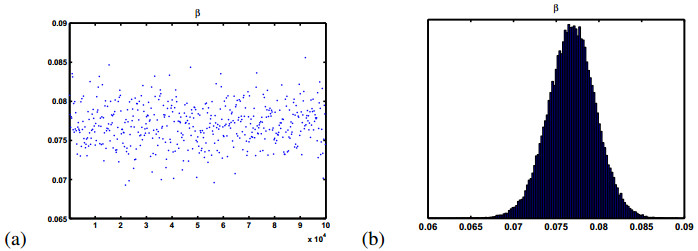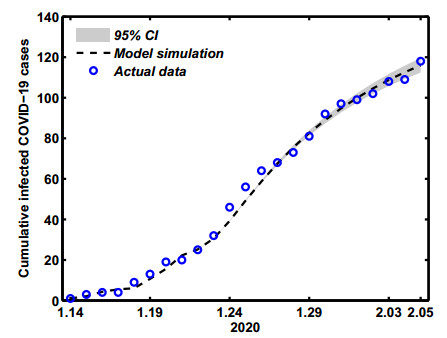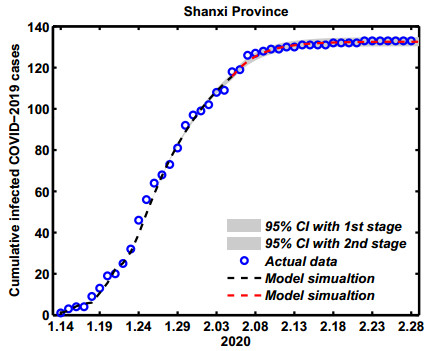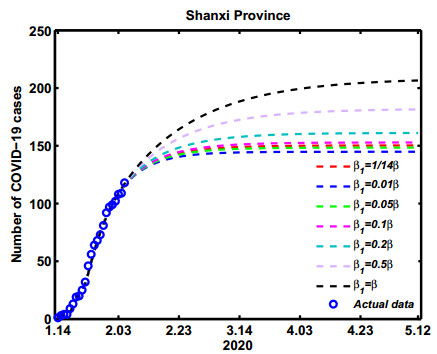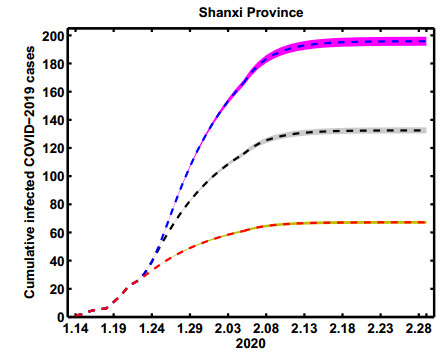| 1.
|
Guo-Rong Xing, Ming-Tao Li, Li Li, Gui-Quan Sun,
The Impact of Population Migration on the Spread of COVID-19: A Case Study of Guangdong Province and Hunan Province in China,
2020,
8,
2296-424X,
10.3389/fphy.2020.587483
|
|
| 2.
|
Rong Yuan, Yangjun Ma, Congcong Shen, Jinqing Zhao, Xiaofeng Luo, Maoxing Liu,
Global dynamics of COVID-19 epidemic model with recessive infection and isolation,
2021,
18,
1551-0018,
1833,
10.3934/mbe.2021095
|
|
| 3.
|
Meng Liu, Raphael Thomadsen, Song Yao,
Forecasting the Spread of COVID-19 under Different Reopening Strategies,
2020,
1556-5068,
10.2139/ssrn.3607977
|
|
| 4.
|
Nao Yamamoto, Bohan Jiang, Haiyan Wang,
Quantifying compliance with COVID-19 mitigation policies in the US: A mathematical modeling study,
2021,
6,
24680427,
503,
10.1016/j.idm.2021.02.004
|
|
| 5.
|
Cody Carroll, Satarupa Bhattacharjee, Yaqing Chen, Paromita Dubey, Jianing Fan, Álvaro Gajardo, Xiner Zhou, Hans-Georg Müller, Jane-Ling Wang,
Time dynamics of COVID-19,
2020,
10,
2045-2322,
10.1038/s41598-020-77709-4
|
|
| 6.
|
Qinxia Wang, Shanghong Xie, Yuanjia Wang, Donglin Zeng,
Survival-Convolution Models for Predicting COVID-19 Cases and Assessing Effects of Mitigation Strategies,
2020,
8,
2296-2565,
10.3389/fpubh.2020.00325
|
|
| 7.
|
Meng Liu, Raphael Thomadsen, Song Yao,
Forecasting the spread of COVID-19 under different reopening strategies,
2020,
10,
2045-2322,
10.1038/s41598-020-77292-8
|
|
| 8.
|
Francesco Capuano,
Modeling Growth, Containment and Decay of the COVID-19 Epidemic in Italy,
2020,
8,
2296-424X,
10.3389/fphy.2020.586180
|
|
| 9.
|
Gui-Quan Sun, Shi-Fu Wang, Ming-Tao Li, Li Li, Juan Zhang, Wei Zhang, Zhen Jin, Guo-Lin Feng,
Transmission dynamics of COVID-19 in Wuhan, China: effects of lockdown and medical resources,
2020,
101,
0924-090X,
1981,
10.1007/s11071-020-05770-9
|
|
| 10.
|
Ming-Tao Li, Jin Cui, Juan Zhang, Gui-Quan Sun,
Transmission analysis of COVID-19 with discrete time imported cases: Tianjin and Chongqing as cases,
2021,
24680427,
10.1016/j.idm.2021.03.007
|
|
| 11.
|
A. Q. Khan, M. Tasneem, M. B. Almatrafi,
Discrete-time COVID-19 epidemic model with bifurcation and control,
2021,
19,
1551-0018,
1944,
10.3934/mbe.2022092
|
|
| 12.
|
S.M.E.K. Chowdhury, Mohammad Forkan, Shams Forruque Ahmed, Praveen Agarwal, A.B.M. Shawkat Ali, S.M. Muyeen,
Modeling the SARS-CoV-2 parallel transmission dynamics: Asymptomatic and symptomatic pathways,
2022,
143,
00104825,
105264,
10.1016/j.compbiomed.2022.105264
|
|
| 13.
|
Leishi Wang, Mingtao Li, Xin Pei, Juan Zhang,
Optimal Breeding Strategy for Livestock with a Dynamic Price,
2022,
10,
2227-7390,
1732,
10.3390/math10101732
|
|
| 14.
|
Ayman Mourad, Fatima Mroue, Zahraa Taha,
Stochastic mathematical models for the spread of COVID-19: a novel epidemiological approach,
2022,
39,
1477-8599,
49,
10.1093/imammb/dqab019
|
|
| 15.
|
Keisuke Ejima, Kwang Su Kim, Ana I. Bento, Shoya Iwanami, Yasuhisa Fujita, Kazuyuki Aihara, Kenji Shibuya, Shingo Iwami,
Estimation of timing of infection from longitudinal SARS-CoV-2 viral load data: mathematical modelling study,
2022,
22,
1471-2334,
10.1186/s12879-022-07646-2
|
|
| 16.
|
Min Peng, Jianing Zhang, Jingrui Gong, Xingqi Ran, Jvlu Liu, Lin Zhang,
Epidemic modeling for the resurgence of COVID-19 in Chinese local communities,
2022,
3,
26664496,
229,
10.1016/j.jnlssr.2022.03.005
|
|
| 17.
|
Jin Guo, Aili Wang, Weike Zhou, Yinjiao Gong, Stacey R. Smith?,
Discrete epidemic modelling of COVID-19 transmission in Shaanxi Province with media reporting and imported cases,
2021,
19,
1551-0018,
1388,
10.3934/mbe.2022064
|
|
| 18.
|
Chung-Han Hsieh,
On Robust Economic Control of Epidemics With Application to COVID-19,
2021,
9,
2169-3536,
167948,
10.1109/ACCESS.2021.3136191
|
|
| 19.
|
Satarupa Bhattacharjee, Shuting Liao, Debashis Paul, Sanjay Chaudhuri,
Inference on the dynamics of COVID-19 in the United States,
2022,
12,
2045-2322,
10.1038/s41598-021-04494-z
|
|
| 20.
|
S. A. A. Biabani, N. A. Tayyib,
A Review on the Use of Machine Learning Against the Covid-19 Pandemic,
2022,
12,
1792-8036,
8039,
10.48084/etasr.4628
|
|
| 21.
|
Jingli Ren, Haiyan Wang,
2023,
9780443186790,
173,
10.1016/B978-0-44-318679-0.00012-0
|
|
| 22.
|
Erik A. Vázquez Jiménez, Jesús Martínez Martínez, Leonardo D. Herrera Zuniga, J. Guadalupe Reyes Victoria,
Discrete models for analyzing the behavior of COVID-19 pandemic in the State of Mexico, Mexico,
2022,
20,
1551-0018,
296,
10.3934/mbe.2023014
|
|
| 23.
|
Mingtao Li, Jin Cui, Juan Zhang, Xin Pei, Guiquan Sun,
Transmission characteristic and dynamic analysis of COVID-19 on contact network with Tianjin city in China,
2022,
608,
03784371,
128246,
10.1016/j.physa.2022.128246
|
|
| 24.
|
Jiang Long, Chenxi Dai, Shanshan Kuang, Han Zhao, Dan Liu, Qing Luo, Kaifa Wang,
A switching dynamic model based on phased COVID-19 data in Chongqing and its evaluation,
2022,
100,
15671348,
105270,
10.1016/j.meegid.2022.105270
|
|
| 25.
|
Sacrifice Nana-Kyere, Francis Agyei Boateng, Paddy Jonathan, Anthony Donkor, Glory Kofi Hoggar, Banon Desmond Titus, Daniel Kwarteng, Isaac Kwasi Adu, Andrei Korobeinikov,
Global Analysis and Optimal Control Model of COVID-19,
2022,
2022,
1748-6718,
1,
10.1155/2022/9491847
|
|
| 26.
|
Abdullah Ali H. Ahmadini, Muhammad Naeem, Muhammad Aamir, Raimi Dewan, Shokrya Saleh A. Alshqaq, Wali Khan Mashwani,
Analysis and Forecast of the Number of Deaths, Recovered Cases, and Confirmed Cases From COVID-19 for the Top Four Affected Countries Using Kalman Filter,
2021,
9,
2296-424X,
10.3389/fphy.2021.629320
|
|
| 27.
|
Michael J. Tildesley, Anna Vassall, Steven Riley, Mark Jit, Frank Sandmann, Edward M. Hill, Robin N. Thompson, Benjamin D. Atkins, John Edmunds, Louise Dyson, Matt J. Keeling,
Optimal health and economic impact of non-pharmaceutical intervention measures prior and post vaccination in England: a mathematical modelling study,
2022,
9,
2054-5703,
10.1098/rsos.211746
|
|
| 28.
|
Buddhi Pantha, Subas Acharya, Hem Raj Joshi, Naveen K. Vaidya,
Inter-provincial disparity of COVID-19 transmission and control in Nepal,
2021,
11,
2045-2322,
10.1038/s41598-021-92253-5
|
|
| 29.
|
Ajay Kumar, Tsan-Ming Choi, Samuel Fosso Wamba, Shivam Gupta, Kim Hua Tan,
Infection vulnerability stratification risk modelling of COVID-19 data: a deterministic SEIR epidemic model analysis,
2021,
0254-5330,
10.1007/s10479-021-04091-3
|
|
| 30.
|
Carlos I. Mendoza,
Inhomogeneous Transmission and Asynchronic Mixing in the Spread of COVID-19 Epidemics,
2021,
9,
2296-424X,
10.3389/fphy.2021.683364
|
|
| 31.
|
Sarita Bugalia, Jai Prakash Tripathi, Hao Wang,
Mathematical modeling of intervention and low medical resource availability with delays: Applications to COVID-19 outbreaks in Spain and Italy,
2021,
18,
1551-0018,
5865,
10.3934/mbe.2021295
|
|
| 32.
|
Rahul Mishra, Hari Prabhat Gupta, Tanima Dutta,
Analysis, Modeling, and Representation of COVID-19 Spread: A Case Study on India,
2021,
8,
2329-924X,
964,
10.1109/TCSS.2021.3077701
|
|
| 33.
|
Harendra Pal Singh, Sumit Kaur Bhatia, Yashika Bahri, Riya Jain,
Optimal control strategies to combat COVID-19 transmission: A mathematical model with incubation time delay,
2022,
9,
26667207,
100176,
10.1016/j.rico.2022.100176
|
|
| 34.
|
M. El Sayed, M. A. El Safty, M. K. El-Bably,
Topological approach for decision-making of COVID-19 infection via a nano-topology model,
2021,
6,
2473-6988,
7872,
10.3934/math.2021457
|
|
| 35.
|
Xiang Wei, Junchan Zhao, Shuai Liu, Yisi Wang,
Identifying influential spreaders in complex networks for disease spread and control,
2022,
12,
2045-2322,
10.1038/s41598-022-09341-3
|
|
| 36.
|
David Jaurès Fotsa-Mbogne, Stéphane Yanick Tchoumi, Yannick Kouakep-Tchaptchie, Vivient Corneille Kamla, Jean-Claude Kamgang, Duplex Elvis Houpa-Danga, Samuel Bowong-Tsakou, David Bekolle,
Estimation and optimal control of the multiscale dynamics of Covid-19: a case study from Cameroon,
2021,
106,
0924-090X,
2703,
10.1007/s11071-021-06920-3
|
|
| 37.
|
Alessio Notari, Giorgio Torrieri,
COVID-19 transmission risk factors,
2022,
116,
2047-7724,
146,
10.1080/20477724.2021.1993676
|
|
| 38.
|
Wenjun Jing, Juping Zhang, Xiaoqin Zhang, Siew Ann Cheong,
Epidemic Dynamics in Temporal Clustered Networks with Local-World Structure,
2023,
2023,
1099-0526,
1,
10.1155/2023/4591403
|
|
| 39.
|
Hyojung Lee, Geunsoo Jang, Giphil Cho,
Forecasting COVID-19 cases by assessing control-intervention effects in Republic of Korea: A statistical modeling approach,
2022,
61,
11100168,
9203,
10.1016/j.aej.2022.02.037
|
|
| 40.
|
Vanshika Aggarwal, Geeta Arora, Homan Emadifar, Faraidun K. Hamasalh, Masoumeh Khademi, Sania Qureshi,
Numerical Simulation to Predict COVID-19 Cases in Punjab,
2022,
2022,
1748-6718,
1,
10.1155/2022/7546393
|
|
| 41.
|
Yas Al-Hadeethi, Intesar F El Ramley, M. I. Sayyed,
Convolution model for COVID-19 rate predictions and health effort levels computation for Saudi Arabia, France, and Canada,
2021,
11,
2045-2322,
10.1038/s41598-021-00687-8
|
|
| 42.
|
2023,
9780443186790,
229,
10.1016/B978-0-44-318679-0.00013-2
|
|
| 43.
|
Muhammad Naeem, Wali Khan Mashwani, Mohammad ABIAD, Habib Shah, Zardad Khan, Muhammad Aamir,
Soft computing techniques for forecasting of COVID-19 in Pakistan,
2023,
63,
11100168,
45,
10.1016/j.aej.2022.07.029
|
|
| 44.
|
R. Prem Kumar, Sanjoy Basu, P.K. Santra, D. Ghosh, G.S. Mahapatra,
Optimal control design incorporating vaccination and treatment on six compartment pandemic dynamical system,
2022,
7,
26667207,
100115,
10.1016/j.rico.2022.100115
|
|
| 45.
|
Daohan Huang, Fenghua Wen, Shunru Li,
Addressing External Shock in Urban Agglomeration: Implications From the Transmission Pattern of COVID-19 in the Beijing-Tianjin-Hebei Area,
2022,
10,
2296-2565,
10.3389/fpubh.2022.870214
|
|
| 46.
|
Eduarda T. C. Chagas, Pedro H. Barros, Isadora Cardoso-Pereira, Igor V. Ponte, Pablo Ximenes, Flávio Figueiredo, Fabricio Murai, Ana Paula Couto da Silva, Jussara M. Almeida, Antonio A. F. Loureiro, Heitor S. Ramos, Sergio Gómez,
Effects of population mobility on the COVID-19 spread in Brazil,
2021,
16,
1932-6203,
e0260610,
10.1371/journal.pone.0260610
|
|
| 47.
|
Jia-Tong Li, Li Li,
The Impacts of Reducing the Infection Rate and Infection Source on the Transmission of Emerging Infectious Diseases,
2022,
2022,
1607-887X,
1,
10.1155/2022/3473538
|
|
| 48.
|
Nora El-Rashidy, Samir Abdelrazik, Tamer Abuhmed, Eslam Amer, Farman Ali, Jong-Wan Hu, Shaker El-Sappagh,
Comprehensive Survey of Using Machine Learning in the COVID-19 Pandemic,
2021,
11,
2075-4418,
1155,
10.3390/diagnostics11071155
|
|
| 49.
|
Gianmario Rinaldi, Prathyush P. Menon, Antonella Ferrara, W. David Strain, Christopher Edwards,
Epidemiological model based periodic intervention policies for COVID-19 mitigation in the United Kingdom,
2022,
12,
2045-2322,
10.1038/s41598-022-19630-6
|
|
| 50.
|
Nitesh Kumawat, Mubasher Rashid, Akriti Srivastava, Jai Prakash Tripathi,
Hysteresis and Hopf bifurcation: Deciphering the dynamics of an in-host model of SARS-CoV-2 with logistic target cell growth and sigmoidal immune response,
2023,
176,
09600779,
114151,
10.1016/j.chaos.2023.114151
|
|
| 51.
|
Sanjay Bhatter, Sangeeta Kumawat, Bhamini Bhatia, Sunil Dutt Purohit,
Analysis of COVID-19 epidemic with intervention impacts by a fractional operator,
2024,
14,
2146-5703,
261,
10.11121/ijocta.1515
|
|
| 52.
|
Ibad Ullah, Nigar Ali, Ihtisham Ul Haq, Imtiaz Ahmad, Mohammed Daher Albalwi, Md. Haider Ali Biswas, Kareem T. Elgindy,
Analysis of COVID-19 Disease Model: Backward Bifurcation and Impact of Pharmaceutical and Nonpharmaceutical Interventions,
2024,
2024,
1687-0425,
1,
10.1155/2024/6069996
|
|
| 53.
|
Jia-Lin Wang, Xin-Long Xiao, Fen-Fen Zhang, Xin Pei, Ming-Tao Li, Ju-Ping Zhang, Juan Zhang, Gui-Quan Sun,
Forecast of peak infection and estimate of excess deaths in COVID-19 transmission and prevalence in Taiyuan City, 2022 to 2023,
2024,
9,
24680427,
56,
10.1016/j.idm.2023.11.005
|
|
| 54.
|
Jiraporn Lamwong, Napasool Wongvanich, I-Ming Tang, Puntani Pongsumpun,
Optimal Control Strategy of a Mathematical Model for the Fifth Wave of COVID-19 Outbreak (Omicron) in Thailand,
2023,
12,
2227-7390,
14,
10.3390/math12010014
|
|
| 55.
|
思凡 王,
Analysis of Equilibrium Points of a Class of Infectious Disease Models with Environmental Viral Load and Vaccine Effects,
2024,
14,
2160-7583,
447,
10.12677/pm.2024.145199
|
|
| 56.
|
JAI PRAKASH TRIPATHI, NITESH KUMAWAT, KOMAL TANWAR, DHANUMJAYA PALLA, MAIA MARTCHEVA,
TRANSMISSION DYNAMICS OF COVID-19 WITH DIABETES IN INDIA: A COST-EFFECTIVE AND OPTIMAL CONTROL ANALYSIS,
2024,
32,
0218-3390,
643,
10.1142/S0218339024500232
|
|
| 57.
|
Shiqian Nie, Xiaochun Lei,
A time-dependent model of the transmission of COVID-19 variants dynamics using Hausdorff fractal derivative,
2023,
629,
03784371,
129196,
10.1016/j.physa.2023.129196
|
|
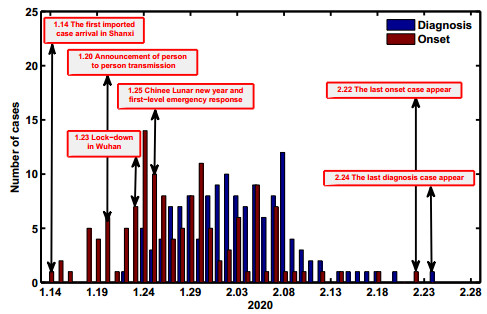









 DownLoad:
DownLoad:


